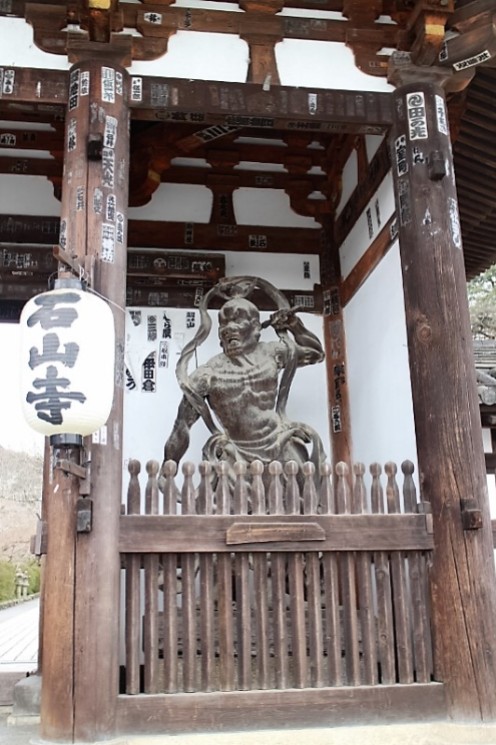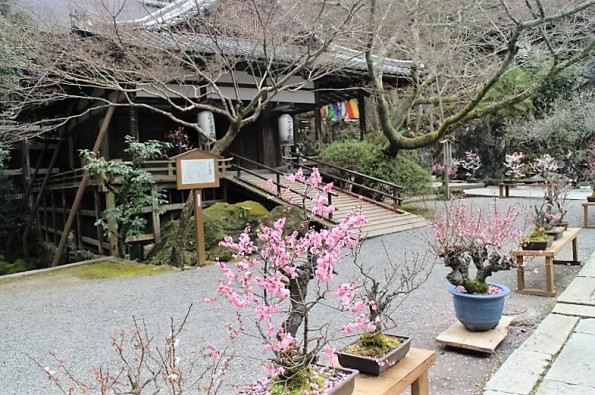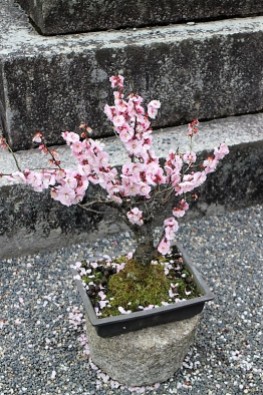Last year, inside the train on my way to work, I happened to see an advertisement poster that had the interesting line “Haru wa agemono” (In Spring, the deep-fried food). This is a pun on the first sentence of “Makura no Soshi” (The Pilow Book), written by a court lady of Heian Period know as Sei Shōnagon, which starts with the words “Haru wa akebono” (In Spring, the dawn). What I find interesting is that (lame?) puns with literary references like this one have been part of the Japanese daily life since a long time ago, and during our visit to Ishiyamadera Temple I couldn’t help but think about this.
去年、通勤電車に乗っていたところ広告に「春はあげもの」という面白い句を見つけました。それは清少納言という平安時代の女流作家が書いた『枕草子』の第一段「はるはあけぼの」との言葉遊びです。面白いのは、日常生活で見つけるこのような文学的な(駄?)洒落はずっと昔からあるそうです。石山寺に行ったときこれが頭に浮かんできました。

The main hall of Ishiyamadera is the oldest structure in the prefecture and also a National Treasure. Being popular since its foundation, many illustrious historical figures visited it and, among those, maybe the most known is another court lady (and Sei Shonagon’s rival) Murasaki Shikibu, who is said to have started writing her most famous work, “Genji Monogatari” (The Tale of Genji) during her visit.
石山寺の本堂は滋賀県の一番古い建物で国宝です。お寺は当初からかなり人気があって、歴史上の有名な人物もいっぱい参拝に来ました。そのなかで、たぶん一番有名なのは本寺の参拝のついでにそこで源氏物語を書き始めた紫式部でしょう。
I’ll go back to the two of them soon enough, but first lets talk about what brought us to this temple. Truth be said, it was my second time, but the first time I went there was during winter. Some plum trees bloomed early and I even took this picture that is my cellphone wallpaper to this day.
あとでまた紫さんと清さんの話がありますが、最初にお寺まで行ったきっかけを言いたいと思います。実は二回目ですが、一回目は冬に行きました。早咲きの梅もあって、いまだに自分も携帯の壁紙になっている下の写真を撮りました。

If you have ever been to some temples in Japan, you probably saw that some of them have their gates guarded by the Niō, a.k.a. Kongōrikishi. These are sculptures that symbolize the guardians of Buddhism who protect the temples. By the way, the ones at Ishiyamadera were sculpted in the late 11th century and are considered Important Cultural Properties of Japan.
日本のお寺を訪れた方は知っていると思いますが、入口の門の左右に仁王(金剛力士)の像をよく見かけます。その仏像はお寺を守る仏教の守護神です。ちなみに、石山寺の仁王の像は11世紀末のもので、日本の重要文化財に指定されています。

Crossing the gates you will be on the way to the temple, which is surrounded by trees that look amazing during both Spring and Fall. At the entrance you will also see this little pond with koi fish:
門をくぐると、春と秋にすごくきれいになる木々におおわれた参道に入ります。入口の辺にこのちっちゃい鯉の池もありました。
Follow the path and take the stairs to get to this open space where they sometimes hold exhibitions. We where lucky enough to see some plum blossom bonsai (bonbai).
道を進んで階段を上るとこの開けたスペースがあります。時にはここで展示会などが開かれるし、私たちはラッキーなことに盆梅展を見ることができました。
The main hall is right ahead, just after some short stairs, and was also decorated with bonbai.
本堂は短い階段を上るとすぐ前にあります。盆梅が飾ってありました。

Something I gotta say: Wear comfortable shoes and clothes (don’t wear a suit like I did). The temple is atop a cliff (kinda), so there are lots of stairs and ramps. On the other hand, climbing them you will be able to see places like this:
ただ一つ言っておきたいのは、楽な靴や服装で行ってください。(私みたいにスーツを着るのはNG)。お寺は山にあるので階段と坂道が多いです。それを上ればこんなシーンを見ることができます。

Up ahead (and back to the literary talk) there’s a small hut where the Haiku poet Matsuo Bashō supposedly composed some poems with Ishiyamadera as a theme, and googling a little bit about this, I found this one:
もう少し進むと庵があって、そこで有名な俳人の松尾芭蕉が石山寺をテーマに句を詠んだと言われています。少し検索してみるとこの句を見つけました:
曙は
まだ紫に
ほととぎす
akebono wa
mada murasaki ni
hototogisu
the sunrise
still purple
a cuckoo sings
The sunrise is still tinted with shades of purple that reminds us of spring, but the poetic persona hears the sound of a cuckoo, a bird that only comes during summer.
曙の空はまだ季節が春と勘違いするほど紫色ですが、俳句の語り手には夏鳥のほととぎすの鳴き声が聞こえます。
This poem was composed at Ishiyamadera, which was already pretty famous as the place of birth of Genji by the time of Bashō’s visit, but alludes to Sei Shōnagon, Murasaki Shikibu’s greatest rival.
この俳句は芭蕉が参拝したときにはすでに源氏物語ですごく有名だった石山寺で詠まれたといわれますが、紫式部の物語ではなく、紫のライバルの清少納言の『枕草子』を仄めかしています。
I don’t have proof, can’t say it’s true and I’m probably going too far by saying this, BUT could Bashō have composed this as if saying “So, I’m at Ishiyamadera, but I’m actually thinking about Sei Shōnagon”? If so, that would totally explain the face of Murasaki Shikibu’s bronze sculpture inside the temple grounds.
もしかして私の素人の深読みかにすぎないと思いますが、そして根拠がないので必ずそうとは言えないけれどもたぶん芭蕉がこの俳句を詠んだとき「石山寺にいるけれど、実は清少納言のことを考えている」というような生意気を言っていたのではないでしょうか。たぶんそれが寺内にある紫の銅像の固い表情の理由のかもしれません。
I have heard a lot about how Sei Shōnagon would write a blog if she was born again in this time and age. That being so, I want to believe that Bashō would be an internet forum troll, posting cheeky comments on Murasaki’s fan page.
もし清少納言がこの時代に生まれ変わったら絶対ブログを書くということをよく耳にします。そうでしたら、芭蕉はきっとインターネットの掲示板などで紫のファンページに味なコメントを投稿していたことを信じたいです。

|
How to get there |
Keihan Ishiyama-Sakamoto Line, 15 min walk from Ishiyamadera station |
|
|
Entrance fee |
Adults / children over 13 |
¥600 |
|
children 13 and under |
¥250 |
|
|
Hours |
From 8:00AM to 4:30PM |
|








